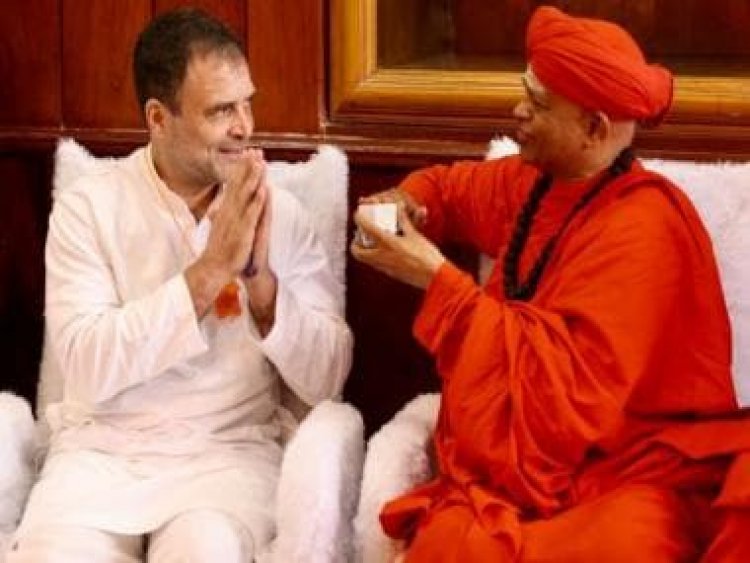Rahul Gandhi gets initiated into the Lingayat sect: What's the community and why is it important to Karnataka politics?
Rahul Gandhi gets initiated into the Lingayat sect: What's the community and why is it important to Karnataka politics?

In what can be seen as a political move, Congress leader Rahul Gandhi got initiated into the Lingayat sect by the seer of Murugha Mutt at Chitradurga on Wednesday.
Inspired by the steps for the ‘Ishtalinga Puje’ demonstrated by the pontiff, Rahul decided to undergo the ‘Linga Deekshe’.
The seer smeared Vibhuti (sacred ash) on Rahul’s forehead. The pontiff then tied an ‘Ishtalinga’ around Rahul’s neck. The Ishtalinga is symbol of ‘the universal force’ to wear. Tied to a thread that lies across the chest or body, Ishtalinga is usually put on children born in Lingayat families at the time of their naming ceremony, but can be tied at any time by persons who accept the Lingayat philosophy that revolves around a universal force, equality and secular values.
As per a PTI news report, Gandhi said, “I have been following a little bit and reading a little bit about Basavanna ji for some time now. So, it’s a real honour for me.” “I will make a request to you if you can send me somebody to teach me a little more in detail about ‘Ishtalinga’ and the practice of Shiva Yoga,” he urged the Muruga Mutt seer.
After the ceremony, Rahul was quoted as saying: “It is an absolute honour to visit Sri Jagadguru Murugharajendra Vidyapeetha and receive the Ishtalinga deeksha from Dr Sri Shivamurthy Murugha Sharanaru.”
It is an absolute honour to visit Sri Jagadguru Murugharajendra Vidyapeetha and receive the 'Ishtalinga Deekshe' from Dr. Sri Shivamurthy Murugha Sharanaru.
The teachings of Guru Basavanna are eternal and I am humbled to learn more about it from the Sharanaru of the Math. pic.twitter.com/5Dgj53roSp
— Rahul Gandhi (@RahulGandhi) August 3, 2022
With this visit, Rahul joins a long list of political leaders who have marked their presence in the monastery in recent times.
Let’s take a closer who at who they are and why they are considered important in Karnataka politics.
Who are the Lingayats?
Members of the Lingayat community follow the teachings of 12th-century saint-philosopher Basavanna, who inspired by the Bhakti movement, rejected temple worship and Brahmin rituals and envisaged a religion free of gender and religious discrimination.
Over the years, several people from backward castes have opted to become Lingayats to escape the rigidity of the Hindu caste system.
Though may believe that the Lingayats and the Veerashaivas are synonymous, that is not the case.
The major difference between the Lingayats and the Veerashaivas is that while the former reject the Vedas and the caste system, the latter don’t. The Lingayats worship Shiva as a formless entity (ishta linga), while Veerashaivas worship the Vedic idol of Shiva with a snake around his neck.
Strong presence in Karnataka
Today, the Lingayat community, centred mostly in the north Karnataka region, is the state’s single largest community — nearly 17 per cent of the state’s population. The Lingayats are dominant in close to 100 of the 224 Assembly seats, making their vote significant.
Post-Independence, the Lingayat voters were loyal to the Congress party. However, there was a shift in votes when the Congress split in 1969 into Congress (I) and Congress (O) — with the latter opposing Indira Gandhi. Most of the senior Lingayat leaders, such as S Nijalingappa and Veerendra Patil went with Congress (O).
Following the Emergency between 1975 and 1977, the Janata Party was formed. In this new political scene, the Congress (O) in Karnataka merged with the Janata Party, which included the Lingayat leaders and the vote bank.
When Veerendra Patil rejoined the Congress, he took the Lingayat votes with him back to the Grand Old Party; but it was not meant to last.
In 1990, then Prime Minister Rajiv Gandhi removed Veerendra Patil from the chief ministerial post, just as the latter was recovering from a stroke.
Rajiv Gandhi announced the dismissal of the chief minister before boarding an aircraft at the Bengaluru HAL airport. This led Lingayat to move away from Congress, which eventually helped the BJP.
Lingayat support for BJP
In the 1994 Karnataka Assembly elections, the Lingayat community exacted revenge for the removal of Veerendra Patil. The Congress was reduced a mere 36 seats from the previously-won 179 seats. Most votes went to BJP, which saw its vote share increase from around four per cent in the state to 17 per cent.
This also led to the rise of BS Yediyurappa in Karnataka political circles and the BJP started to bank on Yeddyurappa’s stature in the Lingayat community.
When Yeddyurappa resigned from the chief minister’s post in July last year, the BJP chose another Lingayat, Basavaraj Bommai, to lead the party in the state — emphasising the importance of the community.
Leaders who have wooed the Lingayats
Rahul’s visit to the Murugha Math assumes significance as elections in the state are scheduled for 2023. Rahul would like to believe that his visit would woo the Mutt leaders, who hold sway with the voters and this could increase the party’s chances.
However, he’s not the only politician in recent times to visit the Mutt.
BJP national president JP Nadda had visited the Mutt in June while Union Home Minister Amit Shah had visited the monastery just before the 2018 Assembly elections.
With inputs from agencies
Read all the Latest News, Trending News, Cricket News, Bollywood News,
India News and Entertainment News here. Follow us on Facebook, Twitter and Instagram.
What's Your Reaction?



























































